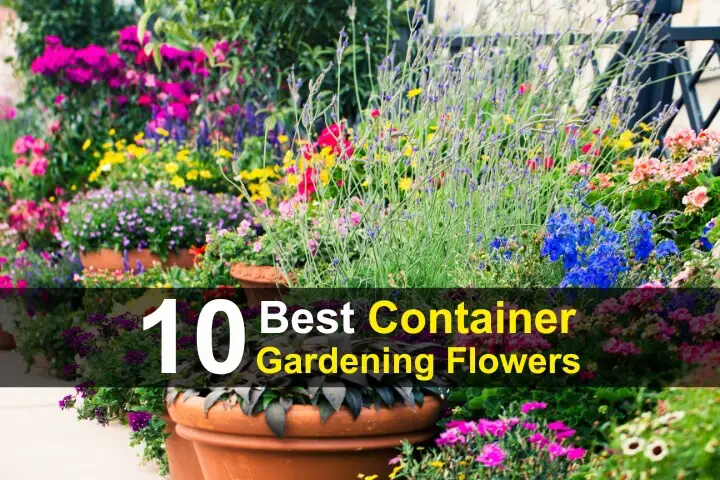Estimated reading time: 11 minutes
Every garden needs flowers, and that includes container gardens. Flowers boost your harvest, attract pollinators, and they’re just plain beautiful. But beyond their good looks, flowers can serve a bigger purpose.
Some flowers help repel pests, while others can improve soil health or even enhance the flavor of nearby vegetables. Plus, many flowers are edible or medicinal, meaning they’re not just for decoration—they can also be useful in the kitchen or home apothecary.
With the right flowers, you can create a vibrant, multi-functional garden in even the smallest of spaces. But with so many options, which flowers should you grow? The best choices are those that do more than just look pretty.
The flowers on this list are either edible, medicinal, pollinator-friendly, or a combination of all three—making them perfect for any container garden.
Want to save this post for later? Click Here to Pin It On Pinterest!
1. Bee Balm (Monarda)

Bee balm, also known as Monarda, is a vibrant flower that comes in shades of red, pink, and purple. It’s a magnet for bees and butterflies, and it can even attract hummingbirds.
The leaves and flowers of bee balm have a slightly minty, citrusy flavor that goes well in salads, fruit dishes, or herbal teas. Traditionally, bee balm has been used to support respiratory health, ease digestion, and even soothe sore throats.
Bee balm is also known for its antimicrobial properties, which can help fight infections. A fresh or dried tea made from the leaves is a great remedy for colds and congestion. Bee balm needs rich soil and does best in full sun, but it can tolerate partial shade.
One thing to watch out for is powdery mildew, a common issue with bee balm in humid areas. To prevent this, be sure to space the plants properly and prune them to improve air circulation. With the right care, bee balm will reward you with a season full of stunning blooms.
2. Borage

Borage is a striking plant with fuzzy stems and star-shaped blue flowers that look great in any container garden. The blooms have a tasty cucumber-like flavor, making them a great for salads, drinks, and some desserts. This hardy plant also attracts bees and other pollinators.
Medicinally, borage is known for its anti-inflammatory properties and is often used to support adrenal health, soothe coughs, and promote healthy skin. Borage seed oil is rich in gamma-linolenic acid (GLA), which helps reduce inflammation. While the flowers and leaves can be made into a mild tea, they should be consumed in moderation as too much can cause liver damage in the long run.
Borage thrives in full sun and reseeds easily, often returning year after year. To prevent it from spreading too much, trim the flowers before they go to seed. With its edible, medicinal, and pollinator-friendly benefits, borage is a must-have for any small-space garden.
3. Calendula

Calendula is a stunning yellow/orange flower that thrives in full sun and attracts all kinds of pollinators. It’s a low-maintenance plant that blooms continuously with regular deadheading, and the flowers aren’t just pretty—they’re also packed with benefits.
Medicinally, calendula has both antiseptic and anti-inflammatory properties. It’s often used in salves, oils, and teas to help heal cuts, rashes, and irritated skin. Calendula-infused oil is a popular ingredient in homemade skincare products thanks to its soothing effects.
Plus, the petals add a tangy flavor to soups, salads, and herbal teas. For these reasons, calendula is great for any container garden.
4. Chamomile

Chamomile is famous for its calming properties, making it a popular herbal remedy for anxiety and insomnia. I personally have a cup of chamomile tea any time I have trouble sleeping, and it really works. Chamomile is also great for easing nausea, reducing bloating, and soothing an upset stomach.
This daisy-like flower isn’t just good for people—it also attracts pollinators and beneficial insects. Bees, butterflies, and hoverflies love it, and it can even improve the health of nearby plants by repelling pests. While it thrives in full sun, it can also do well in partial shade.
To keep chamomile blooming, harvest the flowers regularly to encourage more blossoms. Whether you grow it for its herbal benefits, its ability to support pollinators, or just for its beauty, chamomile is great for any garden.
5. Echinacea (Coneflower)

For many people, echinacea is a go-to herb at the first sign of illness. It’s widely known for its ability to support the immune system, helping the body fight off colds, flu, and other infections. It’s usually made into teas, tinctures, and capsules to reduce the severity and duration of sickness. Echinacea also has anti-inflammatory and antibacterial benefits.
Its bold, purple daisy-like flowers stand tall and attract bees, butterflies, and other pollinators. It’s a hardy perennial that thrives in full sun and well-drained soil, making it easy to care for once it’s established.
To keep echinacea coming back year after year, be sure to cut it back in the fall. This encourages regrowth and ensures plenty of blooms the following season.
6. Johnny-Jump-Ups (Viola Tricolor)

Johnny jump-ups are small, colorful flowers that look amazing in any container garden. Their purple, yellow, and white petals aren’t just pretty—they’re also edible. They’re great in salads, teas, and desserts, adding a mild, slightly sweet flavor. Some people even use them in baked goods or fancy cake decorations.
Johnny jump-ups have a history of medicinal benefits. Traditionally, they’ve been used to soothe respiratory issues like coughs and bronchitis, as well as to help with skin conditions such as eczema and acne. The flowers and leaves contain anti-inflammatory compounds, making them a gentle herbal remedy for several ailments.
They prefer partial sun and moist, well-draining soil, making them a great choice for shaded balconies or patio gardens. They thrive in cooler weather and often reseed themselves, providing continuous blooms with little effort.
7. Lavender

Lavender is one of the best natural remedies for anxiety, stress, and insomnia. Its soothing fragrance has been used for centuries to promote relaxation, making it a staple in teas and essential oils. A cup of lavender tea before bed can ease tension and improve sleep, while lavender-infused oil is commonly used for massages, bath soaks, and even homemade skincare products.
Lavender is also great for cooking. Its slightly sweet flavor goes well with baked goods, herbal teas, and even roasted meats and salads. The flowers can be used fresh or dried. And of course, lavender is a magnet for bees.
To thrive, lavender needs full sun, well-draining soil, and occasional pruning to encourage bushier growth and prevent it from becoming too woody. It prefers drier conditions, so be careful not to overwater it.
8. Marigolds

Marigolds are one of my favorite flowers for natural pest control. I always plant them near potatoes and other crops to help deter aphids, potato bugs, and even nematodes in the soil. Their strong scent confuses pests, making them a great companion plant for vegetables. Plus, they attract beneficial insects like ladybugs and hoverflies, which help keep harmful bugs in check.
Marigolds also have medicinal benefits. They contain anti-inflammatory compounds and are commonly used in skincare to soothe irritation and promote healing. The bright petals are edible and can be used as a natural food coloring or even as a saffron substitute in rice and soups.
Marigolds thrive in full sun and well-drained soil, and while they’re fairly drought-tolerant, they do best with regular watering. Deadheading spent flowers will encourage more blooms throughout the season.
9. Nasturtiums

Nasturtiums have bright orange, yellow, and red flowers that stand out against their round, green leaves. Not only are they beautiful, they’re also edible. The flowers, leaves, and seeds have a peppery flavor similar to arugula, making them great for salads, pestos, sandwiches, and even infused vinegars. The seeds can also be pickled and used as a substitute for capers.
Nasturtiums are a natural immune booster and have both antibacterial and antibiotic properties, making them a great herb to have during cold and flu season. Plus, they’re excellent companion plants, repelling pests like aphids, squash bugs, and whiteflies while attracting pollinators.
They thrive in full sun, but unlike the other flowers on this list, they need slightly poorer soil as rich soil can lead to more leaves than flowers. They also don’t need much water—too much can lead to root rot. If you’re growing them in containers, be sure to choose bush varieties rather than trailing ones unless you have space for them to spill over the edges.
10. Sunflowers (Dwarf Varieties)

As I’m sure you know, sunflower seeds are edible and delicious—especially when roasted and salted (here’s how to do it). But beyond being a tasty snack, they’re also packed with healthy fats, protein, and antioxidants. Even the petals are edible and can be used in teas or as a colorful garnish for salads.
Of course, sunflowers attract bees, which love their nectar-rich flowers, but they also attract birds. Once the flowers go to seed, they provide food source for finches, cardinals, and other seed-loving birds. Growing sunflowers in your container garden can help support local wildlife while adding a bold, cheerful touch to your space.
To grow sunflowers successfully in containers, choose a deep pot to accommodate their long taproots. Dwarf varieties are best for small spaces, but even compact sunflowers can grow pretty tall. They thrive in full sun and need plenty of water, especially during hot weather.
Conclusion
There are plenty of reasons to add flowers to your container garden. The right flowers can deter pests, attract pollinators, give you fresh ingredients for cooking, and even provide medicinal benefits.
Don’t be afraid to experiment with different varieties. A mix of edible, medicinal, and pollinator-friendly flowers will give you the best of all worlds. Try pairing vibrant nasturtiums with calming chamomile, or grow lavender alongside bee balm for a fragrant and beneficial combination.
For the most productive container garden, consider planting flowers alongside herbs and vegetables. Marigolds can help protect tomatoes from pests, while borage improves the growth of strawberries. With the right mix, you’ll have a thriving, beautiful garden that’s as functional as it is beautiful.
Like this post? Don’t Forget to Pin It On Pinterest!
You May Also Like:
Read the full article here




